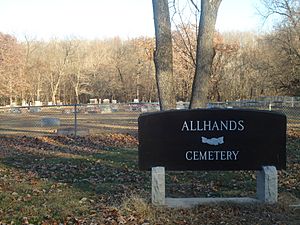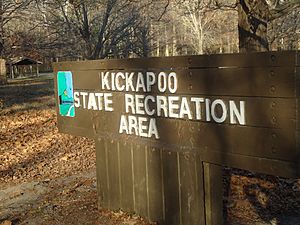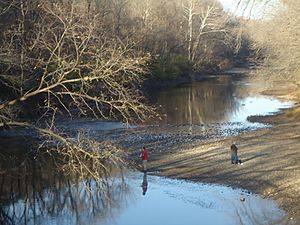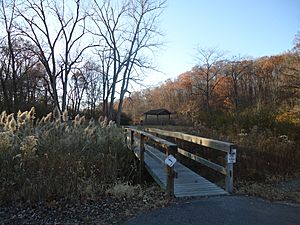Kickapoo State Recreation Area facts for kids
Quick facts for kids Kickapoo State Recreation Area |
|
|---|---|
|
IUCN Category V (Protected Landscape/Seascape)
|
|
| Location | Vermilion County, Illinois, USA |
| Nearest city | Oakwood, Illinois |
| Area | 2,842 acres (1,150 ha) |
| Established | 1939 |
| Governing body | Illinois Department of Natural Resources |
Kickapoo State Recreation Area is a fun state park in Illinois. It covers about 2,842 acres (1,150 ha) in Vermilion County, Illinois, United States. You can find it between Oakwood, Illinois and Danville, Illinois, super easy to get to from I-74.
This park is special because it was the first park in the United States built on land that was once used for strip-mining coal. The state of Illinois bought the land in 1939. Since then, the land has healed and become a beautiful place for nature and outdoor fun.
Today, Kickapoo State Park has 221 acres (89 ha) of ponds and lakes. It also has almost 35 miles (56 km) of trails for hiking, biking, and more! You can go camping, canoeing, fishing, and even scuba diving here. In winter, people enjoy ice fishing and cross-country skiing.
Park History
Kickapoo State Park has a long and interesting past. It was once home to Native Americans, then a place for making salt, and later a coal mine.
Native American Life (500-1500)
Long ago, between the years 500 and 1500, Native American groups lived here. They had a village where the Middle Fork and Salt Fork Rivers meet. A famous Native American leader named Kennekuk, known as the "Kickapoo Prophet," lived here. He worked to make peace between Native Americans and European settlers. The Native Americans lived in this area until the 1500s.
Salt Making (1819-1848)
In 1819, European settlers discovered salt springs in the area. They dug wells to get salty water, called brine. Then, they boiled the brine to make salt. This salt-making business lasted until 1848. At its busiest, they made up to 120 bushels of salt each week! You can still see one of the old iron kettles used for making salt at the Salt Kettle Rest area on I-74.
Coal Mining (1850-1940)
From 1850 to 1940, the park area was used for strip-mining coal. This left many big holes (mine pits) and piles of dirt (spoil piles). Kickapoo was one of the first mines to use machines for strip-mining. Over time, these mine pits filled with water and became the lakes you see today. The bare areas also grew back with trees and plants.
Park Creation and Growth (1940-Today)
The state of Illinois first bought 1,290 acres of land for the park in 1939. More land was added later. A local newspaper owner, Clint C. Tilton, helped make this park happen. Since then, the park has slowly recovered from the mining.
In 2008, there was a plan to close Kickapoo State Park. Many local people and students protested this idea. They gathered at the park to show how much they loved it. Because of their protests, state officials decided to keep Kickapoo open. To celebrate, volunteers helped clean up the park in 2009. Many cleanup efforts have happened since then, thanks to local residents.
Plants and Animals
Kickapoo State Recreation Area is home to many different plants and animals. It's a great place to explore nature!
Unique Nature Preserve
Inside Kickapoo State Park is the Middle Fork Woods Nature Preserve. This special area is the only place in Illinois where you can find the silvery salamander! The preserve has many kinds of trees, like oak, hickory, and maple. Along the ponds, you can see Cypress trees. In the fall, the park's many hardwood trees turn beautiful colors. In spring, you can spot wildflowers like violets and bluebells.
Birdwatching and Wildlife
Over 100 different types of birds have been seen in the park! Some common birds include the belted kingfisher, pileated woodpecker, and great blue heron. You can even get a bird checklist at the park office. Besides birds, you might see white-tailed deer, squirrels, raccoons, rabbits, and muskrats.
Fun Activities
Kickapoo State Park offers many ways to have fun outdoors!
Camping Adventures
The park has 184 campsites for tents and trailers. You can book a spot online or find a walk-in site for tent camping. You can stay for up to 14 days. Almost half of the sites have electric hookups. There are also two shower houses open from May to November.
Fishing Fun
The park's 22 ponds and the Vermilion River are full of fish! You can catch largemouth and smallmouth bass, catfish, bluegill, and crappie. In spring and fall, the lakes are stocked with rainbow trout, which are popular to catch.
Boating on the Water
There are 12 boat ramps on 9 of the lakes. Only electric motors are allowed on these lakes. Kickapoo Adventures, a shop in the park, rents canoes, paddleboards, tubes, and kayaks. They also offer shuttle services for trips down the Middle Fork of the Vermilion River. You can rent boats by the hour for Clear Lake, or take a longer trip down the river. They even have live music at their cafe in the summer!
Hiking Trails
Kickapoo State Park has 7 marked hiking trails. The Out and Back trail is one of the longer ones, winding through forests. The Mountain Bike Trail is 6.5 miles long and circles Stump Pond. Other trails include Clear Lake Trail (3 miles) and Nature Trail (0.75 miles). Part of the High Lake Trail is even accessible for people with disabilities.
Mountain Biking
Over 200 acres of the park are set aside for mountain biking. There are 11 different routes, from easy to difficult. Some tough trails have jumps, steep hills, and winding turns. The bike trails go through forests, old mine areas, and along the Vermilion River. Bike trails are open all year, but they might close during hunting season or if it's too muddy.
Hunting Opportunities
Registered hunters can hunt white-tailed deer, pheasants, rabbits, and squirrels in the park. There are over 1,000 acres for hunting each fall. The park also has trap and archery ranges for visitors.
Other Activities
Besides all the above, you can also go cross-country skiing in winter. Kickapoo State Park is one of the few state parks in Illinois that allows scuba diving! Certified divers can explore Inland Sea and Sportsman's Lake.
Images for kids










